Protected: Exploring California Indigenous Food & Practices Through Traditional Acorn Mush
How is Acorn Mush made?
To cook acorn mush, acorns are first collected by using a pole to strike a tree and retrieve falling acorns or collecting acorns fallen to the ground. Upon collection, the acorns are then cracked open or winnowed.
However, acorns can not be eaten right away. Acorns contain tannic acid, a substance poisonous to humans, that needs to be removed before consumption.
With a stone mortar and pestle, the inner part of the acorn is broken-down and smashed until a powdery substance is reached. Next, the acorn flour-like substance is leached to remove poisonous tannic acid and to remove the bitterness of the acorns. Finally, using a water-proof basket, the substance is cooked atop of heated rocks and the acorn mush is ready to be served. At times, additional toppings such as bay leaves or mint leaves may be added for extra texture and flavoring.
Is Acorn Mush eaten today?
Today, California Native Americans continue to eat acorn mush both using the traditional technique as described above and with new practices using different tools.
On a broader scale, acorns continue to be used in a variety of recipes as they contain large amounts of protein and are often used in acorn flour or acorn meal.
Can you find the following?
Acorn Baskets
Many Northern California tribes, including Hupa, Pomo, Karuk, Lassik, and Yurok peoples, weave beautiful acorn baskets. As the name suggests these handmade baskets are made specially for acorns, particularly for preparing delicious acorn mush!
Tribe members will first use acorn baskets when gathering acorns from nearby oak trees. After collecting acorns, tribe members will shell the acorns and crush their flesh within the acorn basket, making flour. A tribe member will then leach, or wash, the acorn flour in their basket, removing yucky tasting tannins. Finally, tribe members cook the acorn flour with fresh water, in the basket! This is done by adding a very hot stone to the mixture.
Traditionally, these baskets are handwoven from dried native plants, such as beaked hazelnut fibers, conifer (pine tree) roots, and beargrass. By combining different fibers, weavers create intricate patterns, making no two baskets the same. Each basket also has to be woven very tightly, so no acorn mush spills out!
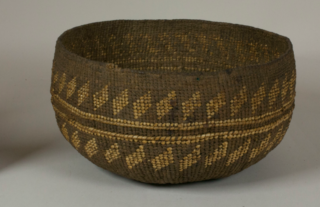
Who made this?
This acorn basket was made by the Yurok people, who live along the Klamath River and Pacific coast.
When was it made?
We know that this particular basket was made over one hundred years ago, with Hearst museum records dating back to 1902. Following traditional techniques, the Yurok people still make these baskets today.
Where was it made?
This basket was made on the land of the Yurok people located in Humboldt, California.
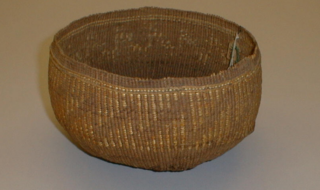
Who made this?
This acorn basket was made by the Hupa people, who live in Hoopa Valley, California near the lower course of the Trinity River.
When was it made?
With Hearst museum records dating back to 1902, we know that this particular basket is over one hundred years old. The Hupa people still make these traditional baskets to this day.
Where was it made?
This basket was made on the land of the Hupa people located in Hoopa Valley, California.
Reflective Questions:
- What colors and patterns do you see in the Yurok acorn basket?
- What colors and patterns do you see in the Hupa acorn basket?
- How are these two baskets different? How are they similar?
- Both of these baskets are over one hundred years old, and local Indigenous communities still make them today. What do you like to make that your great-grandparents also made?
- Acorn baskets were used to collect, wash, and cook acorn mush. What kitchen items do you use to cook your favorite foods?
This section was written by Amanda Styles.
Mush Paddles
In the Klamath region, native tribes carved acorn mush paddles. Unlike paddles for boats or canoes, these paddles were used for cooking, specifically to prepare acorn mush.
Often made from oak wood or maple wood, acorn mush paddles are essential to the traditional acorn mush making process. Generally, acorn mush paddles’ long handles are detailed with stylized geometric patterns, Acorn mush paddles are used to stir acorn mush during the cooking process. Placed against stones over fire in a basket, acorn mush could burn easily or cook unevenly if not stirred constantly and vigorously with the mush paddle. Carvings on mush paddles were traditionally done by men and often made individually by families.
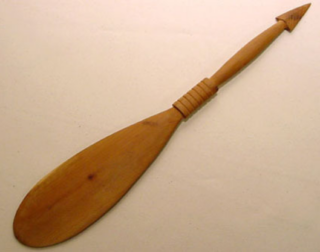
Mush Paddle Replica, 1991
Maple Wood, 44cm
Hupa and Yurok
Who made this?
George Blake Jr, a master woodcarver and former director of the Hoopa Museum, created two mush paddles replicas of the original paddle displayed in the Lowie Museum, with one of them acquired by the Hearst Museum. He oftens made wood-carving models, such as the one displayed above. He studied fine arts and Native American art at the University of California, Davis. Taking his skills back to his community, Blake worked on studying and redefining Hupa and Yurok practices.
When was it made?
This specific mush paddle was first exhibited in 1991. Indigenous people continue to make mush paddles today to continue their wood-carving art practice and traditions. However, they may use different tools and techniques
Where was it made?
The paddle was made on the land of the Hoopa Valley Tribe in Hoopa, California.
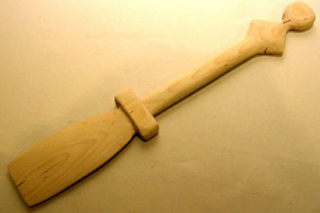
Mush Paddle, 1995
Maple Wood, 45cm x 7cm
Yurok
Who made this?
Frank G. Gist Jr created this mush paddle on commission at the request of an associate research anthropologist. Gist often carved similar items including elk horn purses and acorn spoons.
When was it made?
The paddle was made in March 1995. However, according to Hearst Museum record’s, the earliest mush paddle was dated to 1901.
Where was it made?
This paddle was made in Sacramento, California.
Reflective Questions:
- Why do you think mush paddles are longer than traditional spoons?
- How do the two patterns carved onto the handle of the paddles compare? Do they remind you of anything?
- Do you think there are any differences between a square-ended versus rounded-ended paddle?
- Mush paddles are essential tools used for cooking, especially when baskets are placed above a fire. What tools does your family use when cooking?
References
Students learn how to make acorn mush paddles during Native Maker workshop
This section was written by Ashley Chu.
Spoons
Similar to your spoons at home, spoons were an everyday object created by many tribes in Northern California! These spoons are special though since they had a specific function of eating acorn mush.
In the Klamath region, spoons were carved from wood or elk horn. These spoons were often intricately carved with geometric designs on the handle.
Specifically, men in the tribes more commonly used the spoons to eat the mush, while women were more associated with mussel shells that were collected on coastlines.
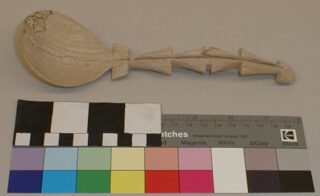
Wood Spoon made from hand and machine tools
20 cm x 6 cm
1-259289
Who made this?
George Blake Jr, an Hupa-Yurok, created this spoon for the Hearst Museum in 1995. Through his work, he combines his ancestral, historical tribe background with the skills he developed in college. George has created many other spectacular works (some that are in this exhibit) that combine the Yurok traditions with modern-day artistic twists and techniques.
When was it made?
George Blake Jr was commissioned to make this piece for the Hearst Museum in March 1955.
Where was it made?
The spoon was made on the land of the Hoopa Valley Tribe in Hoopa, California.
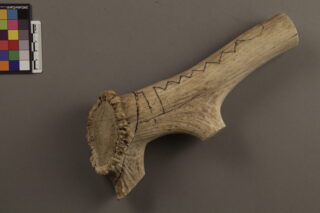
Unfinished Elk Antler-Carved Spoon; 1st stage with pen markings outlining design
27 x 8 cm
1-259293
Who made this?
Frank G. Gist Jr, a craftsman, was commissioned to create this spoon for the Hearst Museum for an exhibition on elk spoon production. Gist also carved the mush paddle that is featured in this exhibit.
When was it made?
The Hearst Museum collected this piece in March 1955.
Where was it made?
This paddle was made in Sacramento, California.
Reflective Questions
- Can you picture what the unfinished spoon would look like if it was done?
- Does the wooden spoon look different to you compared to the antler elk spoon? Do you think the spoons would feel different?
- How long do you think it takes to finish carving a spoon?
- Measure a spoon you have at home. Are the spoons in the exhibit and your spoon at home the same size?
- How do these spoons look the same as the ones you have at home? How do they look different?
This section was written by Neha Shah.
Acorn Mush Interactive Game
Ready to play?
Find and collect everything you need to create acorn mush!

Textual Exhibit References Courtesy of the UC Berkeley Library & HA192CU
- “Wiiwish.” Plant Details: Wiiwish, https://ethnobotany.csusm.edu/search_details.php?plant_id=298.
- People, The. “North American Indian Recipes – Acorn Recipes & Facts!” The Peoples Paths, 23 Nov. 2021, http://www.thepeoplespaths.net/NAIFood/acorns.htm.
- Hoffman, Geralyn Marie, and Lynn H. Gamble. A Teacher’s Guide to Historical and Contemporary Kumeyaay Culture: A Supplemental Resource for Third and Fourth Grade Teachers. Institute for Regional Studies of the Californias, San Diego State University, 2006.
- Amazing Acorns: The Chumash Staple Food – Sbbg.org. https://www.sbbg.org/sites/default/files/pdfs/Amazing%20Acorns.pdf.
